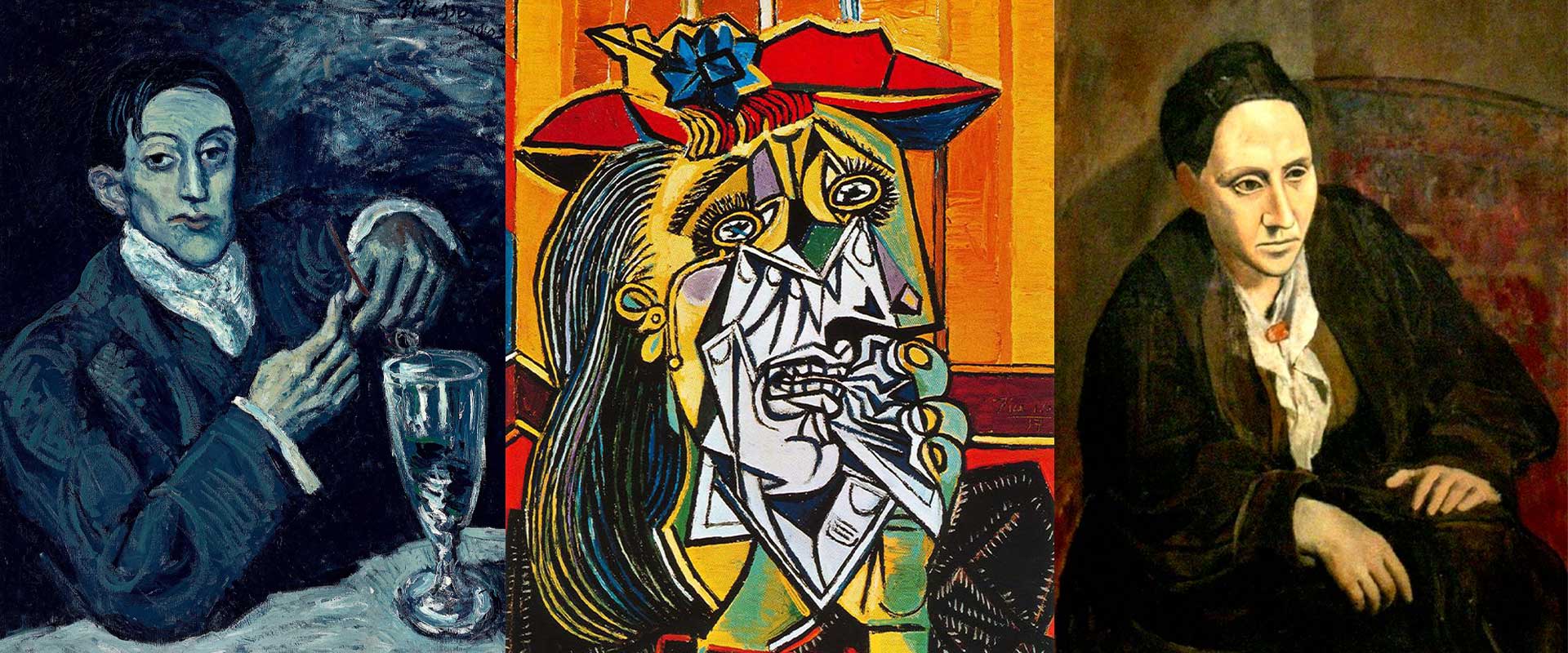Portraiture has long been about capturing likeness—faces, features, and personality frozen in time. But when it comes to Picasso portraits, this tradition was turned inside out. Instead of reproducing reality, Picasso fractured, distorted, and reassembled faces into revolutionary visual codes. His portraits don’t merely represent; they challenge us to think about what it means to see.
Across seven decades, Picasso reinvented portraiture repeatedly, moving from the melancholic realism of the Blue Period to the daring geometry of Cubism and the vibrant, expressive portraits of his muses. These works not only redefined art but reshaped how humanity perceives identity.
Early Portraits – Blue and Rose Period Sensitivity
Before Cubism, Picasso’s portraits carried emotional weight and symbolic undertones.
- Blue Period (1901–1904): Melancholic portraits like Portrait of Angel Fernández de Soto convey despair through cool tones and elongated features.
- Rose Period (1904–1906): Softer, warmer portraits of performers, such as Portrait of Gertrude Stein, reveal psychological depth beyond physical likeness.
These early works already suggested Picasso’s intent: portraits as reflections of the inner world, not just outward appearances.
Cubist Portraits – Shattering Tradition
Picasso’s greatest disruption came with Cubist portraits. Together with Georges Braque, he dismantled the Renaissance tradition of perspective.
Les Demoiselles d’Avignon (1907)
Though a group scene, it introduced Cubism’s fractured forms. Faces inspired by African masks became symbols of raw energy and modernity.
Analytic Cubist Portraits
- Portrait of Daniel-Henry Kahnweiler (1910) shows the Parisian art dealer broken into geometric planes.
- Here, likeness becomes secondary to structure; the sitter is almost a puzzle to decipher.
Synthetic Cubist Portraits
By 1912, Picasso added color and collage elements, giving portraits like Man with a Pipe a reconstructed, layered feel.
As explored in Picasso Cubism: The Art Movement That Changed Everything, these portraits were not distortions but revolutions in how humans could be represented.
Portraits of Women – Muses and Innovation
Picasso’s love life and art were inseparable. Each muse inspired a new way of seeing.
- Fernande Olivier: Appeared in his early Cubist works, marking the shift from realism to abstraction.
- Olga Khokhlova: His wife during the 1910s and 20s, inspiring more neoclassical portraits.
- Marie-Thérèse Walter: Inspired luminous, sensual portraits like Girl Before a Mirror (1932), a blend of tenderness and Surrealism.
- Dora Maar: Captured in haunting portraits such as The Weeping Woman (1937), reflecting political turmoil and personal anguish.
- Françoise Gilot: Inspired colorful, playful portraits of family life in the 1940s.
As detailed in The Weeping Woman, Dora Maar’s portraits are among his most emotionally charged.
Traits of Picasso’s Portraits
- Fragmentation and distortion reveal inner truth, not just outward appearance.
- Use of multiple perspectives challenges realism.
- Emotional resonance—grief, joy, love, or turmoil—transcends likeness.
- Constant reinvention based on relationships and historical context.
- Balance of experimentation with universal human themes.
Later Portraits – Freedom and Reflection
In his final decades, Picasso’s portraits grew more colorful, playful, and reflective. He revisited Old Masters such as Velázquez and Rembrandt, creating reimagined portraits in his unique style. These late works are unapologetically free, proving that even at 90, Picasso was still reinventing representation.
Comparison of Picasso Portraits by Period
| Period | Example Portrait | Style | Key Traits |
|---|---|---|---|
| Blue Period | Portrait of Angel Fernández de Soto | Realist with emotional tone | Melancholy, elongated forms |
| Rose Period | Portrait of Gertrude Stein | Warmer, symbolic | Psychological depth |
| Analytic Cubism | Portrait of Daniel-Henry Kahnweiler | Fragmented Cubist | Geometric abstraction |
| Synthetic Cubism | Man with a Pipe | Color, collage | Reconstructed identity |
| Surrealist/Emotional | The Weeping Woman | Bold, symbolic | Universal grief |
| Late Style | Self-Portrait (1972) | Expressive, colorful | Reflection, confrontation with mortality |
This table shows how Picasso transformed portraiture across every stage of his career.
Why Picasso Portraits Redefined Representation
- They questioned the idea that portraits must look like their subject.
- They transformed faces into symbols of psychology, politics, and culture.
- They turned private muses into universal archetypes of emotion.
- They challenged both the viewer and the tradition of Western art.
As noted in Pablo Picasso Art: How He Shaped the 20th Century, his portraits remain benchmarks for modern representation.
For admirers who want to connect with his vision, collections like Pablo Picasso Wall Art Prints bring these portraits into personal spaces, celebrating their timeless energy.
Lasting Influence of Picasso Portraits
- Inspired movements from Abstract Expressionism to Surrealism.
- Encouraged artists to move beyond likeness to expression.
- Made distortion not a flaw but a form of truth.
- Ensured portraiture remained a central form in modern art.
Conclusion
Picasso portraits redefined what it meant to capture a human face. From the sorrow of the Blue Period to the radical geometry of Cubism and the raw emotion of The Weeping Woman, his portraits pushed representation into new territory. They are not simple likenesses but explorations of identity, emotion, and truth.
By transforming portraiture into a field of constant reinvention, Picasso ensured that every brushstroke was more than representation—it was revelation.
FAQs on Picasso Portraits
What is Picasso’s most famous portrait?
The Weeping Woman (1937) is one of his most iconic and emotionally charged portraits.
Did Picasso paint self-portraits?
Yes, he created self-portraits throughout his career, including expressive late works reflecting on mortality.
Who were Picasso’s main portrait subjects?
His muses and partners—Fernande Olivier, Olga Khokhlova, Marie-Thérèse Walter, Dora Maar, and Françoise Gilot—were central.
How did Picasso change portrait painting?
He abandoned realism, using Cubism, abstraction, and symbolism to capture emotional and psychological truths.
Where can Picasso’s portraits be seen?
Major works are housed at MoMA in New York, Tate Modern in London, Museo Reina Sofía in Madrid, and the Museu Picasso in Barcelona.





